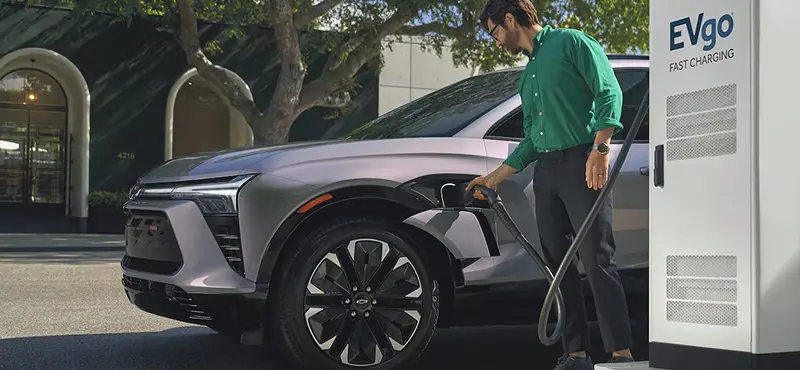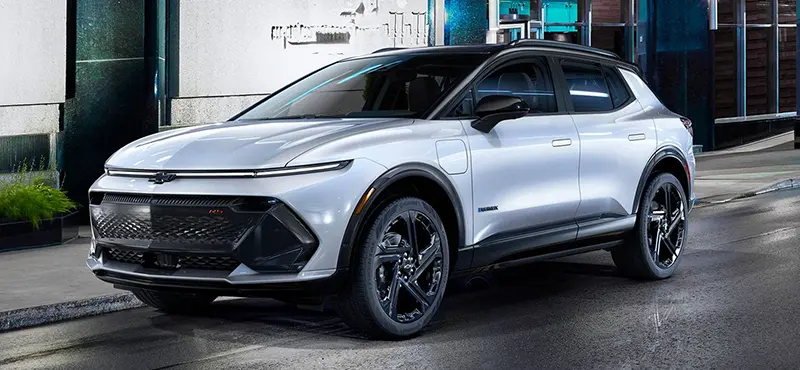

The average cost to buy an electric vehicle is higher than that of an ICE (internal combustion engine) vehicle, but this actually doesn’t mean that electric vehicles are inherently more expensive. The focus of the electric vehicle market in the early days of what we’ll call the modern EV era was on luxury vehicles, and the average price was quite high. Prices have been coming down lately as more and more manufacturers enter the EV market – creating more competition, combined with the decreasing prices of battery technology. But EVs do still tend to favor the higher end of the market. For example, the 2024 Chevrolet Blazer EV starts at $54,200, while the gasoline-powered Blazer starts at $36,795. That sounds like a pretty big difference, but the base trim for the Blazer EV is the RS, and the gasoline version has two trim levels below that. If we compare RS to RS, the gasoline version goes up to $44,195.
On top of that, many EVs, and the Blazer EV is one of these, can be eligible for a $7,500 tax credit. Taking all of this into account, the price difference really isn’t so big. EVs are a bit like diesel engines in this way. Most of the new vehicles with diesel engines that you can get right now in the US are in higher-end heavy-duty trucks that also come with additional equipment that also adds cost. The engine alone doesn’t make the vehicle more expensive, it’s the diesel engine, combined with the additional equipment at those higher trim levels that create the price differential.

Cost Of Gas VS Electricity
This is much less complicated than the initial price breakdown. Electric vehicles are simply less expensive to “fuel” than gasoline vehicles in almost every situation. We’ll talk about the exceptions to this rule before we get into the averages. In Alaska, electricity is expensive enough that the savings don’t amount to much. And in Hawaii, it’s potentially more expensive to pay for electricity. But most people living in the contiguous 48 states pay half of what Hawaiians pay for electricity, so this isn’t an issue for most Americans. The other exception is mostly theoretical. Very large EVs with a lot of power can use a lot of electricity, and their also “very large” batteries cost more to recharge. The Hummer EV is sort of an example of this, but since there is no ICE-powered truck with 1,000 horsepower and 11,500 lb-ft of torque to compare it to, we can only really say it’s more expensive than other EVs to keep charged.
But generally speaking, with the majority of electric vehicles and their ICE counterparts, the “fuel” costs of an EV will be about 60 percent less. For electric cars, this adds up to about $790* per year (one year of driving is defined here as 15,000 miles). For SUVs, it’s about $1,020, and for pickups, $1,310. Obviously, prices will fluctuate, but the difference is enough that it’s safe to assume that the EV will be cheaper to run for the foreseeable future. Now, this does assume that you’re charging at home, and as such, it will require you to purchase and install a home charging station, but these are just a few hundred dollars, and the cost is offset quickly by the fuel savings. In addition, you can add solar power to your home charging equation and save even more. How much more is a larger topic than we’ll get into here, but it is still a component of the cost of owning an EV. Charing at public stations, particularly DC fast chargers, costs more, but the advantage there is that they’re, well… fast.

EV VS ICE Maintenance
Maintenance is another area where there is a clear advantage for electric vehicles. While there are some elements of caring for a vehicle that are universal, such as tires and brake pads, EVs have a lot fewer moving parts, and thus fewer parts to wear out or break. Over the lifetime (lifetime here is defined as 15 years or 200,000 miles) of an ICE vehicle, maintenance costs average out to roughly $9,200*. This is exactly double what maintenance costs for an EV over the same period, which comes to $4,600. Interestingly, even though plug-in hybrids also have an ICE as part of their drivetrain, maintenance costs average out to the same as an EV over the 15-year lifetime, presumably due in part to the fact that the ICE is used a lot less than it would be in a vehicle with that as its only form of propulsion.
Lifetime averages are helpful to look at, but they don’t tell the whole story, and since not everyone keeps a vehicle for its entire lifetime, we should note that different periods in a vehicle’s life come with different costs. For the first 50,000 miles of ownership, an EV costs an average of $0.012 per mile in maintenance. That number goes up to $0.028 for ICE vehicles, thanks to the need for things like oil changes, which EVs don’t require. As you would expect, plug-in hybrids are a bit closer to ICE vehicles, but still lower, at $0.021. Between 50,000 and 100,000 miles, the numbers increase, but mostly at a predictable rate, to $0.028 for EVs and $0.060 for ICE vehicles. Plug-in hybrids are the anomaly here, at $0.031, now more similar to EVs. The gap between EVs and ICE vehicles narrows a bit from 100,000 to 200,000 miles, as more of those universal parts start wearing out. Here, the cost is $0.043 for EVs and $0.079 for ICE vehicles. Interestingly, the Consumer Reports study that we’re getting this data from lists the cost for plug-in hybrids during this period as just $0.033, hence the lifetime average cost that is as low as it is for EVs, but the study does note that a relatively small sample size means that this number is harder to be as confident in. Once again, generalizations about plug-in hybrids are difficult, but it is generally safe to assume that they come with lower fuel and maintenance costs than ICE vehicles, even if it can be tough to predict just how much lower.

Conclusion
If you’re feeling apprehensive about the initial cost of an electric vehicle, it’s clear that this cost is more than offset by the dramatically lower fuel and maintenance costs incurred over the life of the vehicle. In fact, the difference is large enough that you don’t even need to hang onto the vehicle for its entire lifetime in order to save money. This is especially true when it comes to higher-end models and trims, as the initial price difference is much smaller.
